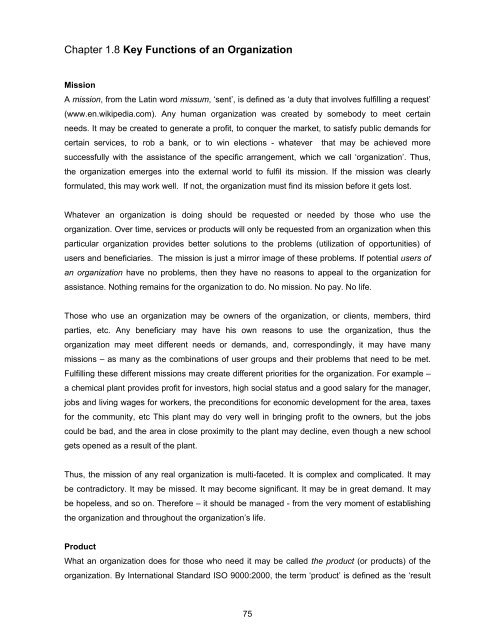Organizational Development: A Manual for Managers and ... - FPDL
Organizational Development: A Manual for Managers and ... - FPDL
Organizational Development: A Manual for Managers and ... - FPDL
You also want an ePaper? Increase the reach of your titles
YUMPU automatically turns print PDFs into web optimized ePapers that Google loves.
Chapter 1.8 Key Functions of an Organization<br />
Mission<br />
A mission, from the Latin word missum, ‘sent’, is defined as ‘a duty that involves fulfilling a request’<br />
(www.en.wikipedia.com). Any human organization was created by somebody to meet certain<br />
needs. It may be created to generate a profit, to conquer the market, to satisfy public dem<strong>and</strong>s <strong>for</strong><br />
certain services, to rob a bank, or to win elections - whatever that may be achieved more<br />
successfully with the assistance of the specific arrangement, which we call ‘organization’. Thus,<br />
the organization emerges into the external world to fulfil its mission. If the mission was clearly<br />
<strong>for</strong>mulated, this may work well. If not, the organization must find its mission be<strong>for</strong>e it gets lost.<br />
Whatever an organization is doing should be requested or needed by those who use the<br />
organization. Over time, services or products will only be requested from an organization when this<br />
particular organization provides better solutions to the problems (utilization of opportunities) of<br />
users <strong>and</strong> beneficiaries. The mission is just a mirror image of these problems. If potential users of<br />
an organization have no problems, then they have no reasons to appeal to the organization <strong>for</strong><br />
assistance. Nothing remains <strong>for</strong> the organization to do. No mission. No pay. No life.<br />
Those who use an organization may be owners of the organization, or clients, members, third<br />
parties, etc. Any beneficiary may have his own reasons to use the organization, thus the<br />
organization may meet different needs or dem<strong>and</strong>s, <strong>and</strong>, correspondingly, it may have many<br />
missions – as many as the combinations of user groups <strong>and</strong> their problems that need to be met.<br />
Fulfilling these different missions may create different priorities <strong>for</strong> the organization. For example –<br />
a chemical plant provides profit <strong>for</strong> investors, high social status <strong>and</strong> a good salary <strong>for</strong> the manager,<br />
jobs <strong>and</strong> living wages <strong>for</strong> workers, the preconditions <strong>for</strong> economic development <strong>for</strong> the area, taxes<br />
<strong>for</strong> the community, etc This plant may do very well in bringing profit to the owners, but the jobs<br />
could be bad, <strong>and</strong> the area in close proximity to the plant may decline, even though a new school<br />
gets opened as a result of the plant.<br />
Thus, the mission of any real organization is multi-faceted. It is complex <strong>and</strong> complicated. It may<br />
be contradictory. It may be missed. It may become significant. It may be in great dem<strong>and</strong>. It may<br />
be hopeless, <strong>and</strong> so on. There<strong>for</strong>e – it should be managed - from the very moment of establishing<br />
the organization <strong>and</strong> throughout the organization’s life.<br />
Product<br />
What an organization does <strong>for</strong> those who need it may be called the product (or products) of the<br />
organization. By International St<strong>and</strong>ard ISO 9000:2000, the term ‘product’ is defined as the ‘result<br />
75
















